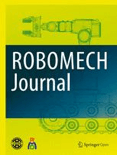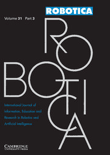
Frontiers in Neurorobotics
Scope & Guideline
Bridging Intelligence and Engineering for Tomorrow's Robotics
Introduction
Aims and Scopes
- Neuroscience-Inspired Robotics:
Research that explores how insights from neuroscience can inform the design and functionality of robotic systems, particularly in enhancing their adaptability and responsiveness to human needs. - Robotic Rehabilitation and Assistive Technologies:
Development of robotic systems aimed at aiding rehabilitation for individuals with disabilities, particularly those recovering from neurological impairments such as stroke. - Human-Robot Interaction (HRI):
Studies focusing on the dynamics of interaction between humans and robots, including the design of interfaces, collaborative tasks, and the psychological impacts of such interactions. - Machine Learning and AI in Robotics:
Utilization of machine learning techniques, particularly deep learning, to enhance robotic perception, decision-making, and autonomy in various environments. - Bio-inspired Control and Learning Systems:
Research on control systems and algorithms that mimic biological processes, aiming to improve robotic movement and interaction with complex environments. - Multimodal Sensory Integration:
Exploration of how robots can integrate various sensory inputs (e.g., visual, auditory, tactile) to improve their functionality and interaction capabilities.
Trending and Emerging
- Neurorehabilitation Technologies:
A surge in studies focusing on the development of robotic systems for rehabilitation, particularly in response to the increasing demand for effective therapies for neurological disorders. - Emotion Recognition and Affective Computing:
Growing research into how robots can recognize and respond to human emotions, which is crucial for enhancing user experience in assistive and companion robots. - Collaborative Robotics:
An increase in research surrounding the development of robots that can work alongside humans in various environments, particularly in manufacturing and healthcare, reflecting broader trends in automation. - Adaptive Learning Algorithms:
Emerging trends in the use of reinforcement learning and other adaptive algorithms that allow robots to learn from their environments and improve their functionality over time. - Human-Centric Robotics Design:
A focus on designing robotic systems that prioritize user needs and experiences, emphasizing usability and interaction quality, which is becoming increasingly important in the field. - Ethics and Safety in Robotics:
Emerging discussions around the ethical implications of robotic technologies and ensuring safety in human-robot interactions, as societal concerns about AI and robotics grow.
Declining or Waning
- Basic Robotics Research:
Research focusing on fundamental robotics without a direct application to neuroscience or human interaction seems to be less prevalent, as there is a stronger push towards applied and interdisciplinary studies. - Traditional Control Systems:
There is a noticeable reduction in publications focused solely on classical control theory in robotics, as more innovative, adaptive, and bio-inspired control methodologies gain traction. - Single-Modal Interaction Studies:
Research that examines isolated human-robot interaction modalities (like only visual or only auditory) is waning, as the trend shifts towards more complex, multimodal integration approaches.
Similar Journals

Artificial Life and Robotics
Transforming Ideas into Applications in Artificial LifeArtificial Life and Robotics, published by Springer, is a prominent journal in the fields of Artificial Intelligence and Biochemistry, Genetics, and Molecular Biology, with an ISSN of 1433-5298 and E-ISSN of 1614-7456. Established in 2005, the journal has continually contributed to knowledge and innovation in these rapidly evolving disciplines and is recognized for its significant impact, as indicated by its quartile rankings in the 2023 category assessments. The journal is currently positioned in Q4 for Artificial Intelligence and Q3 for General Biochemistry, Genetics and Molecular Biology, with a notable ranking of 138/221 and 262/350 in respective research areas. While it currently does not follow an open access model, it remains a valuable resource for researchers, professionals, and students seeking to advance their understanding and application of artificial life and robotic technologies. With an emphasis on interdisciplinary research, this journal aims to bridge theoretical foundations with practical applications, making it an essential platform for cutting-edge studies and discussions in the field.

ROBOMECH Journal
Connecting Scholars and Innovators in Robotics and AIROBOMECH Journal, published by SpringerNature, is a prominent open-access journal dedicated to the fields of robotics, mechanical engineering, and artificial intelligence. Established in 2014, the journal has quickly established itself as a vital platform for disseminating innovative research in control and optimization, instrumentation, and modeling and simulation, earning a commendable Q2 ranking in Mechanical Engineering and multiple Q3 rankings across other relevant fields in 2023. With a commitment to facilitating accessible knowledge sharing, ROBOMECH Journal promotes cutting-edge research that drives advancements in both theoretical frameworks and practical applications within the robotics community. Scholars, engineers, and professionals seeking to contribute to or stay informed about the latest developments in these dynamic fields will find the journal's rich array of articles invaluable. With its open-access model, all published research is freely available, ensuring wide dissemination and increased visibility for authors, thus fostering collaboration and innovation across disciplines.

Journal of Advanced Computational Intelligence and Intelligent Informatics
Connecting Minds in Computational TechnologiesThe Journal of Advanced Computational Intelligence and Intelligent Informatics, published by FUJI TECHNOLOGY PRESS LTD, stands as a pivotal platform in the fields of Artificial Intelligence, Computer Vision, and Human-Computer Interaction. Established in 1997, this Open Access journal has been providing accessible insights into the latest advancements in computational intelligence and informatics since 2007. With its ISSN 1343-0130 and E-ISSN 1883-8014, this journal invites a diverse readership, including researchers, professionals, and students eager to explore innovative methodologies and applications. Despite its current Q4 ranking in the relevant categories, the journal remains committed to contributing valuable knowledge to the academic community and enhancing the global discourse in computational technologies. With its focus on fostering communication and collaboration among scholars, the journal plays an essential role in driving forward the understanding of intelligent systems and their applications in various domains.

ROBOTICA
Innovating Insights in Robotics ResearchROBOTICA is a premier academic journal that serves as a vital resource within the multidisciplinary field of robotics and artificial intelligence. Published by Cambridge University Press, this journal boasts a comprehensive scope that encompasses areas such as computational mechanics, computer vision, control systems, and software applications. With an impressive range of quartile rankings in 2023, including Q2 in key categories like Computational Mechanics and Control and Optimization, ROBOTICA represents a significant contribution to its field, providing researchers and practitioners with cutting-edge insights and advancements. Although it follows a traditional subscription model, the journal maintains a commitment to accessibility through its esteemed indexing performance and robust academic standing, evidenced by Scopus rankings within the top percentiles across multiple relevant disciplines. Covering an expansive period from 1983 to 2024, ROBOTICA is essential for anyone looking to stay at the forefront of robotics research and innovation.

Multimodal Technologies and Interaction
Enhancing Interaction Through Innovative Research.Multimodal Technologies and Interaction, published by MDPI since 2017, is an esteemed open-access journal based in Switzerland, dedicated to the exploration and advancement of innovative multimodal systems that enhance user experience across various digital platforms. With its commitment to disseminating high-quality research in diverse areas such as Computer Networks and Communications, Human-Computer Interaction, and Neuroscience, the journal has rapidly established itself within the academic community, achieving a commendable position in Scopus rankings including Q2 in both Computer Networks and Communications and Computer Science Applications. As an essential resource for researchers, professionals, and students alike, Multimodal Technologies and Interaction fosters interdisciplinary dialogue and supports the development of cutting-edge technologies, ensuring that advancements in multimodal interaction are accessible to a global audience. Scholars can benefit from its Open Access format, allowing unrestricted access to influential studies that shape the future of technology and interaction design.

Advanced Intelligent Systems
Bridging Disciplines for a Smarter Tomorrow.Advanced Intelligent Systems, published by WILEY, stands as a prominent Open Access journal dedicated to the interdisciplinary exploration of intelligent systems, with a focus on materials science, engineering, and computer science. Since its establishment, the journal has fostered innovative research, providing a platform for the dissemination of findings that push the boundaries of artificial intelligence, human-computer interaction, and systems engineering. Although it is relatively new, having converged from 2023 to 2024, it ranks within various Scopus categories, showcasing its growing influence in fields such as mechanical engineering and computer vision. With an emphasis on accessibility, the journal has been Open Access since 2019, ensuring that cutting-edge research is available to a global audience of researchers, professionals, and students, thus driving forward the frontiers of intelligent systems development.

International Journal of Automation and Computing
Exploring the Frontiers of Applied Mathematics and TechnologyInternational Journal of Automation and Computing, published by SPRINGERNATURE, is a premier academic journal dedicated to advancing knowledge in the fields of applied mathematics, computer science applications, control and systems engineering, and modeling and simulation. With an impressive impact factor and consistently ranked in the Q1 Quartile for its respective categories in 2023, the journal is recognized for its high-quality research and contributions to the automation and computing sectors. This journal provides open access to its articles, promoting the dissemination of innovative ideas and methodologies across a global audience. Based in China but serving an international community, the journal is key for researchers, professionals, and students looking to stay at the forefront of automation and computing technologies. Its rigorous peer-review process ensures that published works meet the highest scientific standards, making it an essential resource for those seeking to deepen their understanding and engage in cutting-edge research.

Journal of Field Robotics
Elevating Robotics Research to New HeightsJournal of Field Robotics, published by WILEY, is an esteemed peer-reviewed journal focusing on the cutting-edge developments in the area of robotics applied to real-world environments. With an ISSN of 1556-4959 and an E-ISSN of 1556-4967, this journal serves as a vital platform for researchers and professionals keen on advancing the fields of Computer Science Applications and Control and Systems Engineering, where it has earned a prestigious Q1 ranking in both categories as of 2023. The journal, which converges in its studies from 2006 to 2024, showcases original research that enhances the understanding and implementation of robotic systems in various fields, thus promoting innovative solutions to complex challenges. Access to the journal is through subscription-based options, ensuring a rigorous selection of high-quality research articles, reviews, and technical notes that contribute significantly to the academic community. With a solid Scopus ranking—39th out of 817 in Computer Science Applications and 17th out of 321 in Control and Systems Engineering, both in the 95th and 94th percentiles respectively—Journal of Field Robotics is essential reading for anyone interested in the future of robotics technologies and their transformative impact.

International Journal of Humanoid Robotics
Exploring the Intersection of Humanity and MachinesInternational Journal of Humanoid Robotics, published by World Scientific Publishing Co Pte Ltd, is a leading platform for researchers and practitioners in the fields of artificial intelligence and mechanical engineering. With an ISSN of 0219-8436 and an E-ISSN of 1793-6942, this journal has established itself as a significant resource since its inception in 2004. Spanning various topics from robotic design and control to human-robot interaction, it serves a diverse interdisciplinary audience. The journal’s impressive ranking in the Scopus database, positioned in the third quartile for both categories in 2023, reflects its growing impact in the academic community. Although not open access, the journal provides crucial insights that advance the understanding of humanoid robotics and foster innovative solutions to real-world challenges. Researchers, professionals, and students are encouraged to engage with this essential resource as it continues to shape the future of robotics through rigorous scientific inquiry and scholarly collaboration.

AUTONOMOUS ROBOTS
Shaping Tomorrow’s Autonomous Solutions.AUTONOMOUS ROBOTS, published by SPRINGER, is a leading academic journal that serves as a pivotal platform for the dissemination of cutting-edge research in the field of Autonomous Robotics. With an ISSN of 0929-5593, this esteemed journal has been at the forefront of innovation since its inception in 1994, and it continues to thrive with a vision extending to 2024 and beyond. Recognized in the Q1 category of Artificial Intelligence, it boasts a commendable ranking of #85 out of 350 in Computer Science and Artificial Intelligence, positioning it within the 75th percentile of researchers' preferred publications. The journal features a range of subjects related to autonomous systems, including but not limited to robot perception, action planning, multi-agent systems, and autonomous interactions, catering to an audience that spans researchers, industry professionals, and students alike. Scholars can access a wealth of peer-reviewed articles that contribute to both theoretical frameworks and practical applications, ensuring the relevance of the work published within its pages. Located in Dordrecht, Netherlands, AUTONOMOUS ROBOTS exemplifies a commitment to advancing the science of robotics, making significant contributions to the knowledge base and inspiring new developments within the field.